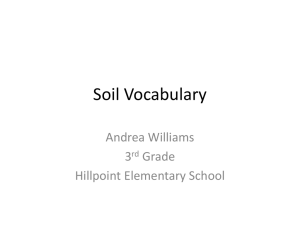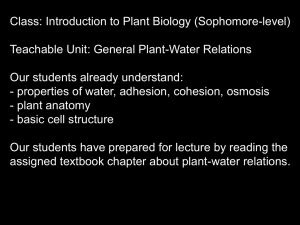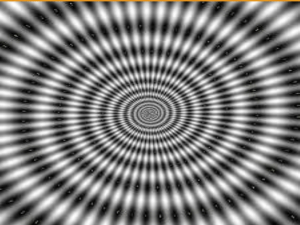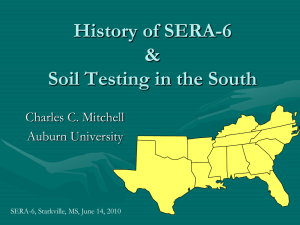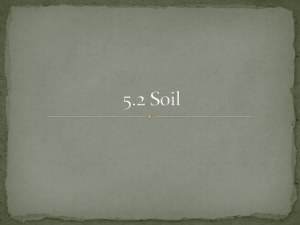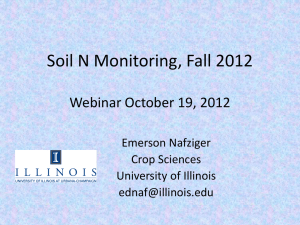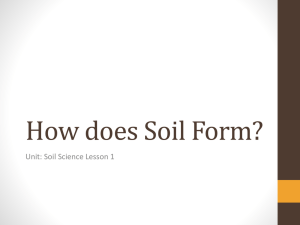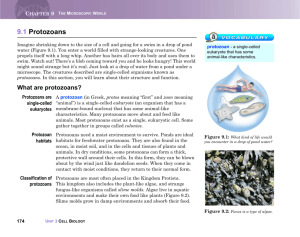PSAE ACT Practice Science Test
advertisement
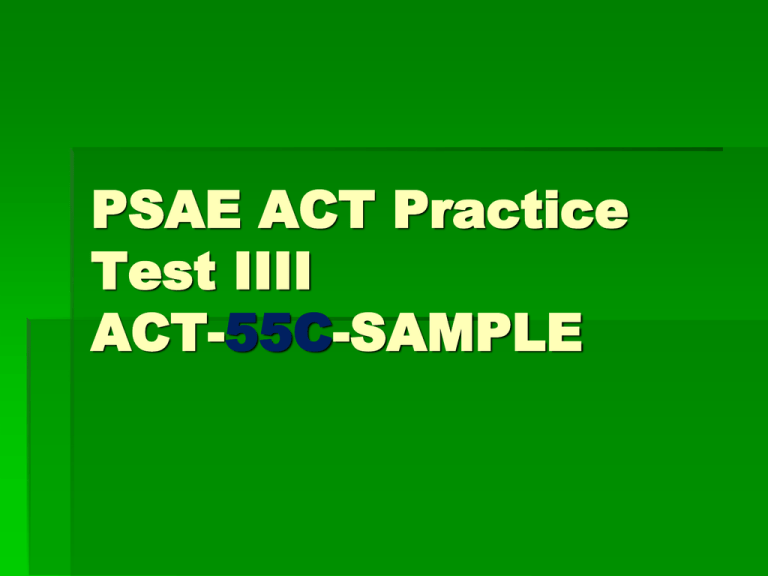
PSAE ACT Practice Test IIII ACT-55C-SAMPLE PI 1 1. According to the information in the passage, a sample of marble from which of the following buildings would be expected to have the greatest concentration of calcium nitrate on its surface? D. A 25-year-old building in a city with high levels of nitrogen dioxide in the atmosphere. PI 2 Each sample of marble had a surface area of 24 square centimeters (cm2). Initial surface area of the sample was the same for all 4 marble samples. PI 3 Comparing results of Samples 1 and 3 supports the hypothesis that marble corrodes more quickly when exposed to: A. sulfuric acid than when exposed to nitric acid. PI 4 50 4.1 In Experiment 1, if the scientist had added nitric acid with a concentration of 50 ppm to a sample of marble with a surface area of 24 cm2, approximately how much marble would have been lost after 24 hours? G. 4.1 mg PI 5 If the scientist were to repeat Experiment 1, but break every sample of marble into 4 pieces to increase the surface area exposed to the acid, how would the mass of marble lost most likely be affected? When a sample is broken into 4 pieces, the surface area is increased. The acid can then affect more of the marble surface. X4= surface area = 10 cm2 Surface area = 24 cm2 surface area = 40 cm2 PI 6 According to the passage, if a scientist wants to study the effect of nitrogen dioxide on marble corrosion, the scientist should measure the amount of which of the following substances on the surface of the marble? Nitric acid, produced when nitrogen dioxide reacts with water, reacts with calcium carbonate to form calcium nitrate. J. Calcium nitrate PII 7 Difference = 12° 8° 8° C 9° CC According to Table 2, by approximately how many degrees does the boiling point of a linear hydrocarbon differ from that of a branched hydrocarbon with the same number of carbon atoms? B. 10° C PII 8 According to Tables 1 and 3, which hydrocarbon has the lowest density? Find the lowest values for density in Table 3, then match the number of carbons for that hydrocarbon with those in Table 1. G. Branched butane PII 9 As the number of carbon atoms increases, the boiling point: D. Increases as the density increases. PII 10 How do the structures of butanes (4 carbon atoms) correspond to their density? The cyclic butane has a higher density than the linear and the linear has a higher density than the branched. PII 11 We’re looking for boiling points which are lower than 10° C. Which hydrocarbons in Table 2 are gases at 10° C? D. The linear and cyclic propanes and and linear and branched butanes. PIII 12 In Experiment 1, if an additional trial were conducted using the plastic sphere, the sphere’s measured time of fall would most likely be nearest: F. 0.70 sec. G. 0.75 sec. H. 0.80 sec. J. 0.90 sec. PIII 13 The students measured the times required for a 200 g wooden sphere and a 50 g plastic sphere to fall 2.5 m to Earth The students conducted Experiments 1 and 2 using both the wooden sphere and the plastic sphere, most likely to determine if a sphere’s acceleration was affected by its composition and its: A. mass. PIII 14 When an object falls from a low altitude to Earth and gravity is the only force acting upon it, the object will have an acceleration of 9.8 meters/second2 (m/sec2). The best evidence that the spheres were influenced by forces in addition to gravity was that, during each experiment, the observed values of acceleration were: significantly lower that 9.8 m/sec2. PIII 15 If the plastic spheres are dropped 5 times from an altitude of 1m, the average measured time of fall will most likely be: What we know: In Experiment 1, the plastic spheres were dropped at a distance of 2.5 m to Earth. The average time for fall of the plastic spheres for 2.5 m to Earth is 1.60 sec. If 2.5 m yields 1.60 sec, then 1m would yield 0.64 sec. So…… A. less than 0.80 sec. PIII 16 In Experiment 1, should the students have used a stopwatch that was accurate to the nearest second, and why? H. No, because the spheres took less than 1 sec to fall to Earth. PIII 17 To show that a sphere’s acceleration is affected by air resistance, in addition to the experiments in the passage, which of the following experiments can be performed? A. In a sealed vacuum chamber containing no air, the spheres are dropped from heights of 2.5 m and 9.7 m. PIV 18 The Cellularization Theory does NOT include the hypothesis that the earliest metazoans were: F. ciliated. G. aquatic. H. hollow. J. bilaterally symmetrical. PIV 19 The development of which of the following characteristics is addressed in the passage by the Colonial Theory, but NOT by the Cellularization Theory? A. Body symmetry B. Ciliated tissues C. Multinucleated cells D. Reproductive cells PIV 20 Supporters of all 3 theories would agree with the conclusion that the first metazoans: F. evolved from protozoans. G. are older than the first protozoans. H. had many nuclei in each cell. J. were radially symmetrical. PIV 21 Which of following types of organisms, if present today, would provide the most support for the Colonial Theory? A. Flagellated protozoans living in dense colonies B. Flagellated protozoans living in hollow colonies C. Ciliated protozoans living in dense colonies D. Ciliated protozoans living in hollow colonies PIV 22 Assuming that the Separate Line Theory is correct, which of the following conclusions can be made about modern hydras, which are radially symmetrical, and modern flukes, which are bilaterally symmetrical? F. Hydras and flukes evolved from radially symmetrical metazoans. G. Hydras and flukes evolved from bilaterally symmetrical metazoans. H. Hydras and flukes are more closely related to each other than to protozoans. J. Hydras and flukes are only distantly related through protozoans. PIV 23 Which of the following questions is raised by the Colonial Theory, but is NOT answered in the passage? A. Why did the first flatworm-like metazoans have cilia? B. Why were some colonial cells better suited for reproduction? C. How could 2 lines of metazoans evolve from protozoans? D. How were multinucleated cells transformed into cells with single nuclei. PIV 24 Proponents of all 3 theories would agree with which of the following conclusions about the evolution of metazoans? F. Bilaterally and radially symmetrical metazoans evolved at different times. G. The first metazoan was a jellyfish-like organism with flagella. H. The evolution of metazoans led to the extinction of protozoans. J. Bilaterally symmetrical metazoans are more advanced than radially symmetrical metazoans. PV 25 Which of the following assumptions was made in the design of Experiment 1? D. Simulated plant cover acts like natural plant cover in protecting the soil from erosion by water. PV 26 According to the results of Ex 1 and 2, one can minimize soil erosion by: Increasing plant cover, decreasing the amount of trampling, and using land covered with Soil 2. PV 27 If Experiment 2 were repeated using a different soil containing 50% sand, which of the following would be the expected water storage in soil hoofprints and sediment runoff on a plot subjected to 60% trampling? Soil 1 = 60% Soil 2 = 25% Soil (different) = 50% Water stored = 10% less than the 60% sand, so 10% of 0.79 cm = 0.71 cm PV 28 In Experiment 2, after 30% trampling, water stored in the two soil types was similar, but sediment runoff was not. Which of the following statements is the most likely explanation for the difference in sediment runoff? A soil with a smaller percent sand is less susceptible to erosion than soil with a higher percent sand. PV 29 If Experiment 1 were repeated using a soil containing 50% sand with 70% plant cover, which of the following would be closest to the expected sediment runoff from this soil? Soil 1 = 60% sand = 492 g/m2 Soil 2 = 25% sand = 200 g/m2 PV 29 Soil = 50% sand = ? A. B. C. D. 175 g/m2 200g/m2 425 g/m2 500 g/m2 PV 30 To further investigate the effect of vegetation cover on soil erosion, the scientists should repeat Experiment: F. 1, using plots planted with different grasses. PVI 31 According to Figure 2, at approximately which of the following altitudes would a weather instrument measuring air temperature be unable to distinguish between tropical and arctic air masses. A.12.0 km, B. 13.5 km, C.15.5 km, 16.5 km PVI 32 According to Figure 1, several atmospheric layers overlap one another. Which of the following describes atmospheric layers that share part of a common altitude range? F. G. H. J. Stratosphere and mesosphere Stratosphere and thermosphere Mesosphere and thermosphere Mesosphere and chemosphere PVI 33 According to Figure 1 and Table 1, if the weather instruments rose above 13.7 km, the air pressure would most likely: A. Increase to more than 1,000 mb. B. Stay at 200 mb. C. Decrease to less than 200 mb. D. Decrease to 1,000 mb. PVI 34 According to Figure 1, a weather instrument reading an air pressure of 5 mb is most likely in which of the following layers. F. Troposphere G. Ozonosphere H. Mesosphere J. Ionosphere PVI 35 The air temperature decreased with increasing altitude on Day 2 only. PVII 36 According to the passage, the most effective antiseptic against microorganisms is the one that leaves the: G. Lowest percentage of surviving microorganisms in the shortest time of exposure. PVII 37 According to the information presented in Table 1 and Figure 1, what conclusion about the use of alcohol as an antiseptic may be reached? A. Dissolving chemical agents in alcohol increases their effectiveness as anitseptics. PVII 38 Is the statement “tinctures are more effective against microorganisms than aqueous solutions of the same antiseptic” supported by the information presented in Figure 1, and why? F.Yes, because tincture of Merthiolate is more effective against microorganisms than is aqueous Merthiolate. PVII 39 After you thoroughly wash your hands with plain soap and water for 2 minutes, your hands probably carry: D. Fewer bacteria than before; most are still alive. PVII 40 According to Figure 1, if a researcher prepared a disinfectant solution of 60% alcohol, the time of exposure required to kill 90% of the bacteria present would be: J. Greater than 120 sec.


